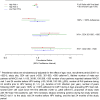Factors affecting the prevalence of strongly and weakly carcinogenic and lower-risk human papillomaviruses in anal specimens in a cohort of men who have sex with men (MSM)
- PMID: 24278140
- PMCID: PMC3835810
- DOI: 10.1371/journal.pone.0079492
Factors affecting the prevalence of strongly and weakly carcinogenic and lower-risk human papillomaviruses in anal specimens in a cohort of men who have sex with men (MSM)
Abstract
Background: MSM are at higher risk for invasive anal cancer. Twelve human papillomaviruses (HPVs) cause cervical cancer in women (Group 1 high-risk HPVs (hrHPVs)) and 13 HPVs are probable/possible causes (Group 2 hrHPVs) of cervical malignancy. HPVs rarely associated with malignancy are classified as lower-risk HPVs (lrHPVs).
Materials and methods: Dacron-swab anal-cytology specimens were collected from and data complete for 97% (1262/1296) of Multicenter AIDS Cohort Study (MACS) men tested for HPVs using the Linear Array assay. Multivariate Poisson regression analyses estimated adjusted prevalence ratios for Group 1/2 hrHPVs and lrHPVs, controlling for the effects of age, race, ethnicity, sexual partnerships, smoking; HIV-infection characteristics, treatment, and immune status among HIV-infected men.
Results: HIV-infected men showed 35-90% higher prevalence of Group 1/2 hrHPVs and lrHPVs than HIV-uninfected men, and higher prevalence of multi-Type, and multiple risk-group infections. CD4+ T-cell count was inversely associated with HPV Group 2 prevalence (p<0.0001). The number of receptive anal intercourse (RAI) partners reported in the 24 months preceding HPV testing predicted higher prevalence of Group 1/2 hrHPVs. Men reporting ≥30 lifetime male sex partners before their first MACS visit and men reporting ≥1 RAI partners during the 24 months before HPV testing showed 17-24% and 13-17% higher prevalence of lrHPVs (p-values ≤0.05). Men reporting smoking between MACS visit 1 and 24 months before HPV testing showed 1.2-fold higher prevalence of Group 2 hrHPVs (p = 0.03). Both complete adherence to CART (p = 0.02) and HIV load <50 copies/mL (p = 0.04) were protective for Group 1 hrHPVs among HIV-infected men.
Conclusions: HIV-infected men more often show multi-type and multi-group HPV infections HIV-uninfected men. Long-term mutual monogamy and smoking cessation, generally, and CART-adherence that promotes (HIV) viremia control and prevents immunosuppression, specifically among HIV-infected MSM, are important prevention strategies for HPV infections that are relevant to anal cancer.
Conflict of interest statement
Figures



References
-
- Clifford GM, Polesel J, Rickenbach M, Dal Maso L, Keiser O, et al. (2005) Cancer risk in the Swiss HIV Cohort Study: associations with immunodeficiency, smoking, and highly active antiretroviral therapy. J Natl Cancer Inst 97: 425–432. - PubMed
-
- Forman D, de Martel C, Lacey CJ, Soerjomataram I, Lortet-Tieulent J, et al. (2012) Global burden of human papillomavirus and related diseases. Vaccine 30 Suppl 5F12–23. - PubMed
Publication types
MeSH terms
Grants and funding
- U01-AI-35042/AI/NIAID NIH HHS/United States
- U01-AI-35041/AI/NIAID NIH HHS/United States
- U01-AI-35039/AI/NIAID NIH HHS/United States
- U01 AI035040/AI/NIAID NIH HHS/United States
- UL1TR000424/TR/NCATS NIH HHS/United States
- U01 AI035039/AI/NIAID NIH HHS/United States
- K07 CA140360/CA/NCI NIH HHS/United States
- U01 AI035042/AI/NIAID NIH HHS/United States
- U01 AI035041/AI/NIAID NIH HHS/United States
- UM1-AI-35043/AI/NIAID NIH HHS/United States
- P30 MH058107/MH/NIMH NIH HHS/United States
- UM1 AI035043/AI/NIAID NIH HHS/United States
- UL1 TR000424/TR/NCATS NIH HHS/United States
- U01-AI-35040/AI/NIAID NIH HHS/United States
LinkOut - more resources
Full Text Sources
Other Literature Sources
Medical
Research Materials
Miscellaneous

